Today, we will delve into the fascinating world of the Bezel Setting, a beloved choice among diamond and jewelry enthusiasts worldwide.
Right from the start, it’s important to highlight that if you desire a jewelry piece with a rich historical significance that will stand the test of time while enhancing your personal style, opting for a bezel-set design is a fantastic decision.
To gain a comprehensive understanding of Bezel settings, we will explore various aspects such as the definition of a Bezel Setting Ring, a comparison between Bezel Settings and other setting types, the advantages and disadvantages associated with this style, and much more.
So, let’s embark on our exploration of Bezel Settings and unravel all there is to know about them!
DESIGN YOUR OWN ENGAGEMENT RING: START WITH A SETTING OR START WITH A DIAMOND. IT’S REALLY UP TO YOU!
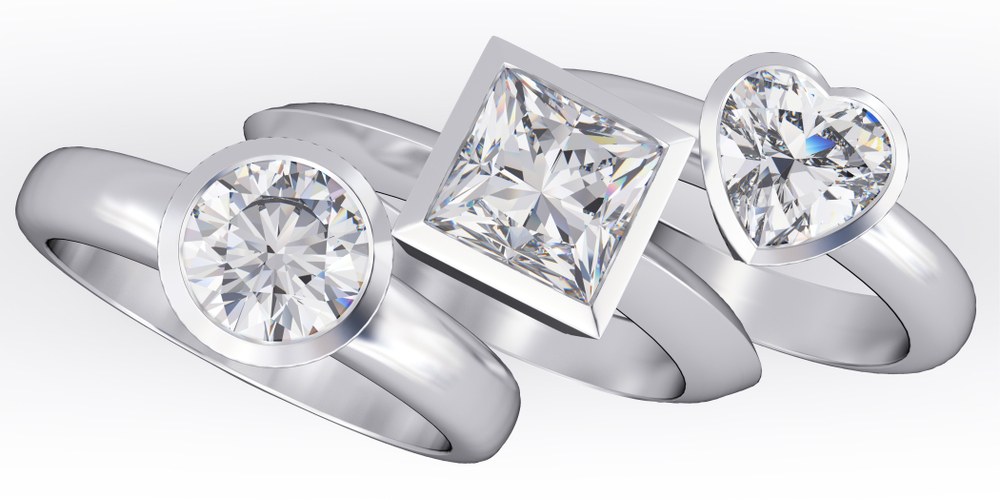
Basic’s About Bezel Settings
The bezel setting is a classic jewelry setting style where a metal ring surrounds and secures a diamond or gemstone. Known for its simplicity and elegance, bezel settings have been used since ancient times and are commonly found in antique and antique-inspired jewelry.
While bezel settings have historical associations, modern technologies have allowed for the creation of sleek and contemporary designs. While a full bezel setting, which completely encircles the gemstone, is the most common type, partial bezel settings are also popular. Partial bezels secure the gemstone by surrounding only its edges, and they are known as half bezels, open bezels, or semi-bezels.
Bezel settings come in various styles, from smooth and unadorned for a modern aesthetic to highly detailed with engravings for a romantic or vintage appeal. This setting style can be used with any diamond cut, as it follows the outer shape of the stone.
One of the notable advantages of a bezel setting is its exceptional protection for the gemstone. The metal enclosure provides a streamlined form that complements modern, classic, and luxurious styles. Bezel settings are particularly suitable for colorful gemstones and trendy jewelry, as they can also safeguard delicate stones.
In the next chapter, we will explore the different types of bezel settings in more detail, providing a comprehensive understanding of this versatile and protective setting style.
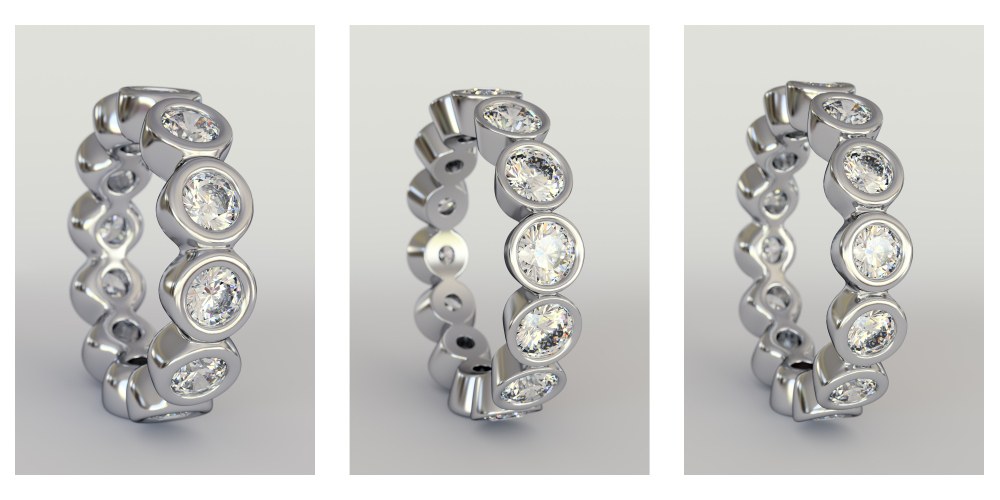
The Origins of Bezel Set Jewelry
Bezel settings have a rich history and have been worn by affluent and influential women for centuries. Their enduring appeal lies in their timeless design, as bezel-set jewelry can maintain a stylish and contemporary look, even after many years. These settings are particularly well-suited for heirloom pieces that are passed down through generations.
One of the great advantages of bezel settings is their versatility. They can be crafted with thick or thin metal rings, fully or partially encircling the stone, and can be made from various metals. Bezel settings can also be combined with other setting styles to create visually striking jewelry pieces.
The bezel setting is believed to be the earliest method of setting stones and has been found in antique jewelry and ring designs. Over time, the bezel setting has evolved, and modern interpretations feature minimalist and streamlined aesthetics, accommodating different gemstone shapes and colors.
Let’s compare bezel settings with other popular setting styles:
Channel vs. Bezel Settings:
- Channel settings create a continuous and linear design, accentuating the shank of a ring and embellishing wedding bands. They are ideal for smaller gemstones, while bezel settings can be used with larger stones.
- While both settings offer security and snag-free wear, channel settings do not necessarily showcase the main gemstone like a bezel setting does.
Prong vs. Bezel Settings:
- Prong settings use tiny metal prongs to hold the diamond, providing minimal protection. In contrast, bezel settings encircle the diamond with a metal rim, offering enhanced security and reduced risk of damage.
- Prong settings allow more light to penetrate the diamond, maximizing its brilliance, while bezel settings reduce the amount of light, resulting in a less dazzling appearance.
- Bezel settings can hide imperfections and blemishes on the diamond’s sides and edges, while prong settings display the diamond’s actual size without altering its perceived carat weight.
- Prong settings are recommended for individuals with an active lifestyle, while bezel settings are generally more robust.
Flush vs. Bezel Settings:
- Flush settings securely fix stones into the metal band, without emphasizing the central gemstone as much as a bezel setting.
- Bezels allow stones to stand out as they can be elevated at different heights on the band, making them more versatile and popular in various styles.
- Both settings limit the amount of light and brightness, but they are well-suited for busy and hands-on environments.
Overall, bezel settings offer a timeless and secure option for jewelry lovers, combining elegance, versatility, and protection for the gemstone.
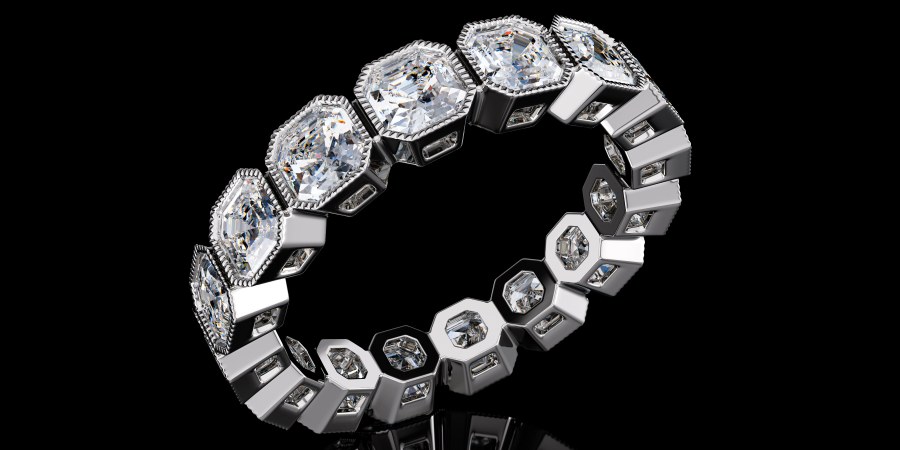
What Are the Different Kinds of Bezel Settings?
Bezel settings can be categorized into two main types:
- Full bezel settings: In this type, a thin metal ring completely encircles the center stone, securely fastening it to the band. This design is particularly suitable for individuals with busy lifestyles, as it offers enhanced protection.
- Partial-bezel settings: Also known as half-bezel settings, these settings feature metal surrounding the central stone on two sides, allowing some of the stone’s edges to remain visible (the “top” and “bottom” portions). Partial-bezel settings provide a balance between showcasing the stone and providing protection, offering a unique aesthetic appeal.
In addition to these primary types, there are several other variations of bezel settings available:
- Split-bezel settings: These settings feature a bezel with splits or gaps, creating an intriguing visual effect while securely holding the stone in place.
- High-set bezel settings: The center stone in this type of bezel setting is positioned higher against the band, drawing attention and emphasizing its presence.
- Low-profile bezel settings: The stone is set flush with the engagement ring’s band, with the tip of the stone embedded within the ring and the edges encompassed by the band. This setting creates a sleek and contemporary look.
- Plain bezel settings: A basic bezel setting consists of an unadorned metal rim that encloses the central stone, allowing the focus to be on the stone itself.
- Fancy bezel settings: Jewelers can incorporate additional decorative elements such as micropavé, a halo, milgrain designs, or side stones to enhance the bezel-set center stone in bezel engagement rings, creating a more intricate and captivating appearance.
These various types of bezel settings offer versatility and options for customization, ensuring that you can find a bezel setting that suits your personal style and preferences.
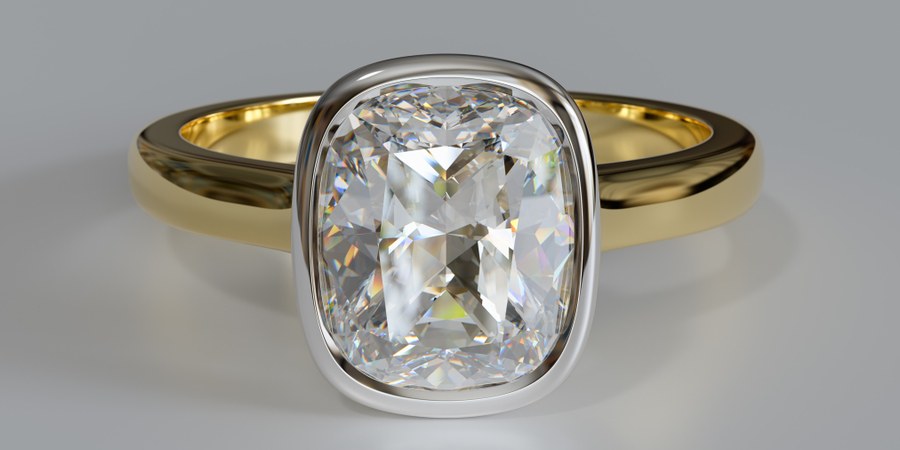
Advantages of Bezel Settings
When it comes to discussing the advantages of bezel settings, it is important to note that they offer numerous pros and minimal cons.
- Enhanced security: One of the significant advantages of bezel settings is their ability to secure the diamond more firmly than other settings, including prong settings. The custom-fit metal rim of the bezel setting tightly holds the central diamond, reducing the risk of it coming loose or falling out.
- Sleek and modern appearance: Bezels settings provide a sleek and modern aesthetic that sets them apart from traditional engagement ring settings. If you and your partner prefer contemporary jewelry, a bezel setting can be a visually appealing choice.
- Ideal for active lifestyles: Bezels settings are an excellent option for individuals with busy lives and active careers due to their durability. The custom-fit rim securely holds the diamond in place, making it less likely to become loose during physical activities such as jogging, hiking, or sports. It is also a suitable option for those with demanding jobs that may pose a risk to prong settings.
- Easy maintenance and cleaning: The relatively simple design of most bezel settings makes maintenance and cleaning straightforward. There are no prongs to regularly inspect or clean, simplifying the care of both the diamond and the setting.
- Clothing-friendly design: Bezels settings are less likely to catch and snag on clothing or other materials due to their design. Unlike prong settings, there is no risk of the metal getting deformed or damaged if it comes into contact with hard surfaces.
- Protection against damage: The metal rim of a bezel setting not only holds the diamond securely but also provides protection against damage. By surrounding the diamond’s edges, it helps prevent chipping and potential breakage, making it particularly beneficial for diamond shapes prone to chipping, such as princess cut, marquise cut, and pear-shaped diamonds.
- Conceals visual flaws: The bezel setting covers more of the diamond’s surface area compared to prong settings, making it effective at concealing certain common visual flaws. Inclusions or imperfections located at the diamond’s edges can be hidden by the metal rim of the bezel setting, making them less noticeable to the naked eye.
It’s important to note that choosing a bezel setting does not mean that you can select a diamond with a poor clarity grade and expect it to appear flawless. While the bezel setting can mask certain imperfections, diamonds with significant inclusions towards the center are unlikely to be completely concealed.
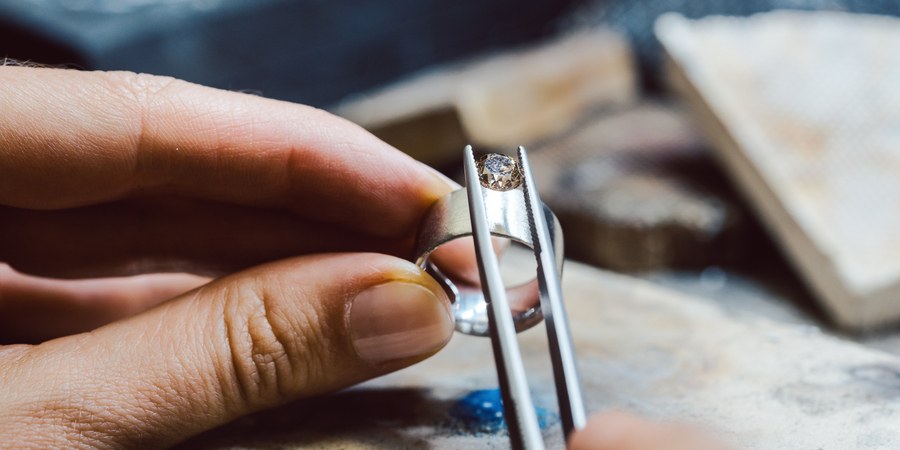
Disadvantages of Bezel Settings
As mentioned earlier, there are only a few drawbacks associated with bezel settings that we want to highlight:
- Reduced brilliance: If you desire a diamond that sparkles intensely, a bezel setting may not be the best choice. The bezel setting can sometimes diminish the brilliance and shine of the stone, resulting in less overall sparkle.
- Higher cost: Bezels settings are not the most budget-friendly option available. The weight of the metal and the complexity involved in creating the setting can make bezel rings more expensive compared to other settings. When purchasing a bezel ring, you can expect to pay a premium for the quality of the metal used.
- Perception of smaller stone size: Bezel settings often appear larger compared to other settings, which can give the impression of a smaller or less dazzling center stone. The metal surrounding the diamond may create an optical illusion that reduces the perceived size or visual impact of the stone.
- Reduced light reflection: Since the bezel setting wraps around the edges of the central diamond, it can limit the amount of light entering the stone from the sides. This can result in reduced light reflection and potentially decrease the overall brilliance of the diamond.
It’s important to consider these potential drawbacks alongside the advantages when deciding if a bezel setting is the right choice for you.
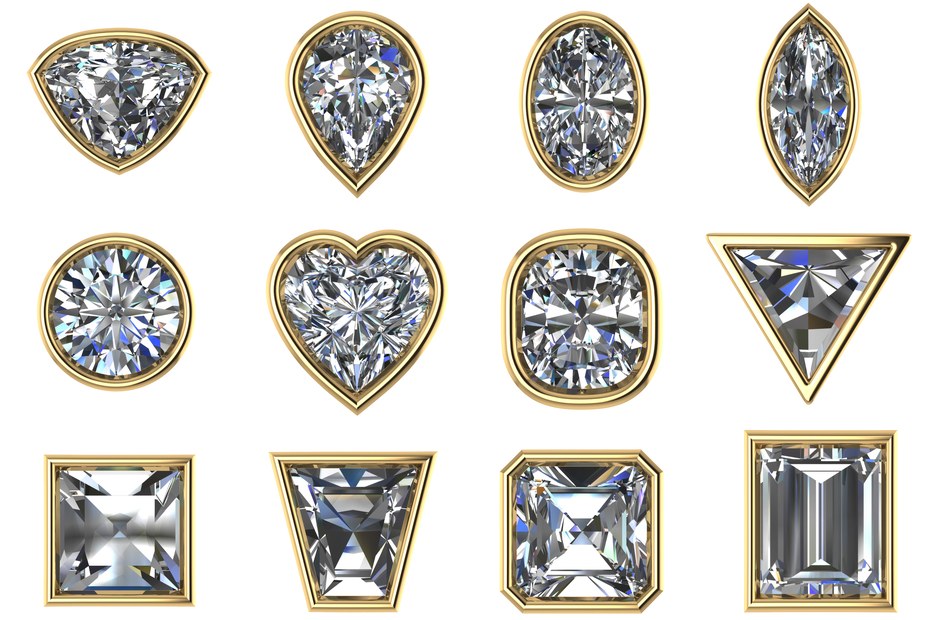
The Average Price Of Bezel Settings
While bezel settings offer a more straightforward ring design, the price of an engagement ring with a bezel setting can vary significantly. Here are some factors that mainly determine the price of a bezel setting:
- Additional diamond accents: If the bezel setting includes a halo, pavé, or side-stone diamonds, the price will be higher compared to a plain bezel setting. The presence of additional diamonds adds to the overall cost of the ring.
- Metal type: The type of metal used in the bezel setting can significantly impact its price. For example, an 18K gold or platinum bezel ring will generally be more expensive than one made of 14K gold. The quality and rarity of the chosen metal influence the final cost.
- Gemstone quality: The quality and type of gemstone set in the bezel can also affect the price. Higher-quality diamonds or gemstones with unique characteristics may increase the overall cost of the ring.
It’s important to note that even though diamonds are rated high on the Mohs scale for hardness, they can still shatter. While they are scratch-resistant, they are not indestructible. The risk of damage to the diamond exists, especially if it is struck with enough force or comes into contact with hard surfaces.
Repairing a bezel setting can be more challenging and costly compared to a basic prong setting. If the metal surrounding the diamond becomes damaged, it may require intricate repairs that involve working with both the metal and the diamond, which can increase the cost and difficulty of the repair.
Considering these factors, it’s crucial to carefully evaluate the long-term maintenance and potential repair costs associated with a bezel setting.
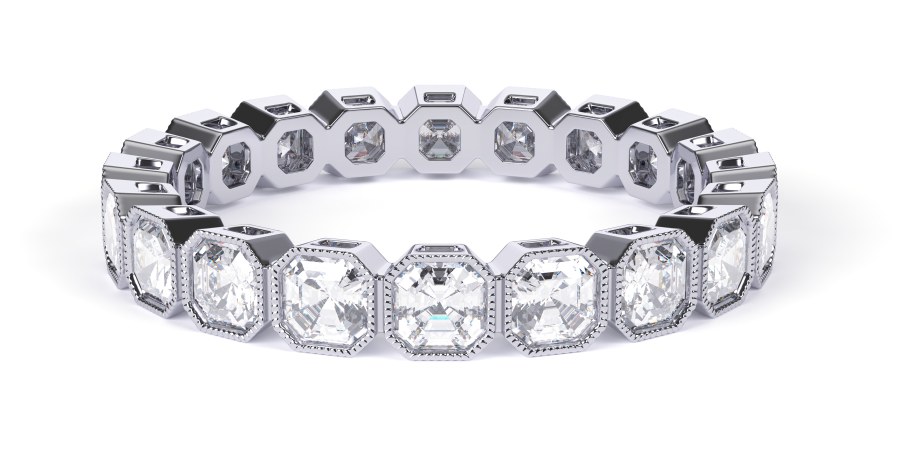
Bezel Settings – FAQ (Frequently Asked Questions)
Why Choose a Bezel Engagement Ring?
A bezel engagement ring offers a contemporary look and is well-suited for an active lifestyle. Its custom-fit metal securely holds the diamond in place, making it one of the most secure settings available.
What is a Bezel Set Engagement Ring?
The bezel setting is a popular choice for engagement rings. Instead of prongs, a thin metal rim surrounds the diamond, providing protection by encircling it.
Is Bezel Setting Common in Diamond Engagement Rings?
While not as common as classic settings like solitaire or prong settings, the bezel setting is quite popular and consistently ranks among the top engagement ring settings.
Which Stone Shapes Work Best in a Bezel Setting?
While bezel settings can accommodate various stone cuts, many experts suggest that brilliant round cuts look particularly beautiful in bezel settings.
When Did Bezel Settings First Appear?
Bezel settings are one of the earliest methods used in jewelry creation and stone setting. They can be seen in antique jewelry and ring designs.
What are the Pros of Bezel Settings?
Bezel rings do not snag on fabrics like prong settings do. They have fewer crevices, making cleaning around the diamond easier. A diamond in a bezel setting is secure and cannot be easily knocked loose. Bezel settings are ideal for those with busy lifestyles.
What are the Cons of Bezel Settings?
When shopping at physical jewelry stores, the selection of bezel engagement ring styles may be limited. Bezel settings allow less light to enter the diamond compared to conventional settings, which can impact its brilliance.
How are Bezel Settings Made?
Bezel settings are created by carefully hammering the metal rim of the bezel, ensuring it is smooth and securely encases the diamond. This craftsmanship requires skill and precision to achieve a sharp and stable bezel shape.
Do Diamonds in Bezel Settings Sparkle?
Yes, diamonds sparkle in bezel settings. Well-cut stones set in well-designed bezels will dazzle and showcase their brilliance. However, poorly cut stones or bezels that cover too much of the diamond’s surface may result in a dull appearance. Careful selection of both the stone and bezel is important for optimal sparkle.
Bezels are also a great choice for softer gemstones like emeralds or morganite that require additional protection from everyday wear and tear.

Final Thoughts
Today’s article focused on Bezel Settings: Everything You Need to Know, highlighting this popular engagement ring style known for its protective qualities.
Throughout the piece, we emphasized the reasons why a bezel setting is an excellent choice. It offers exceptional protection for your gemstone, ensuring its safety.
Additionally, we compared bezel settings to other popular options like prong and channel settings, providing a comprehensive understanding of their unique features.
We also covered various aspects such as the benefits and drawbacks of bezel settings, cleaning methods, pricing considerations, and more. Our FAQ section aimed to address any lingering questions and clear up any confusion you may have had.
We sincerely hope that you enjoyed delving into the fascinating world of bezel setting rings, known for their exceptional beauty and distinctive style!


